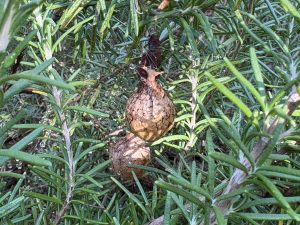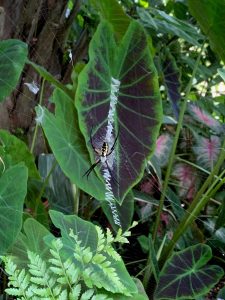One of our well known spiders found in landscapes is the Yellow and black garden spider, Argiope aurantia. Most people will recognize this beautiful spider that rests in a large web with a zigzag web pattern in the middle called a stablementum. A wide variety of insects will be caught in the web throughout the summer, with many prey larger than the spider itself. The Yellow and black orb weaver is just one of our beneficial spiders in landscapes.
As fall approaches each female garden spider leaves us a wonderful gift in the garden. She will create a very distintive egg sac that can be hidden in plants or hang in the corner of a porch. The sac is brown and pear shaped, supported by strands of web attached to branches or structures. Hundreds of eggs are inside and although they hatch in late fall, the spiderlings will stay in the sac until the spring. A large number of spiderlings will not survive due to predation and other factors, but a few will continue development to adorn your garden in the following season.

Egg sacs of the Yellow and black garden spider in a rosemary. Photo by Beth Bolles, UF IFAS Extension Escambia County.
If you did have a garden spider in your landscape this summer, just be a little more careful when maintaining plants. You don’t want to accidently remove the overwintering egg sac. Although this large spider can be startling for many people, they are not aggressive and are considered beneficial in the garden.
- Garden Spider Egg Sacs - October 23, 2025
- Saving Malabar Spinach Seeds - October 17, 2025
- Improve Butterfly Habitat with Trees - September 18, 2025

